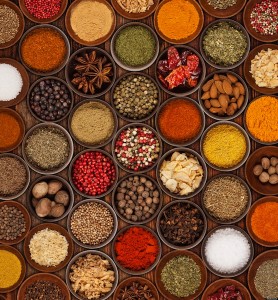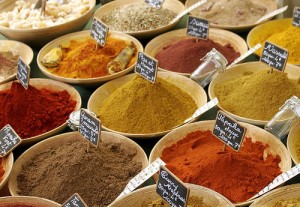 Ask most people what foods they envision when they hear the words “eat healthy”, and you are likely to get responses such as salad, fruit, veggies, and probably even taste-less. But, nutritious meals don’t have to be bland and boring. In fact, with a little creativity and the right ingredients, you can prepare flavorful and nutritious cross-cultural cuisines that will make your taste buds dance!
Ask most people what foods they envision when they hear the words “eat healthy”, and you are likely to get responses such as salad, fruit, veggies, and probably even taste-less. But, nutritious meals don’t have to be bland and boring. In fact, with a little creativity and the right ingredients, you can prepare flavorful and nutritious cross-cultural cuisines that will make your taste buds dance!
Many different cultures utilize some of the same herbs and spices to create their unique blend of flavors. For instance, the use of cumin is commonly found in recipes for Mexican, Spanish, Indian, and North African dishes. While cinnamon can be found in meals from around the world including Germany, the Caribbean, Mexico, and Greece, just to mention a few. Using various combinations of herbs and spices, you can feed your cravings for ethnic foods without leaving the house. For example, using the same basic vegetable medley, you can create a zesty Italian vegetable roast one night and a spicy Indian stew the next, all by adjusting a few simple spices.
Healing Benefits of Spices & Herbs
Spices are far more powerful than just being a flavorful ingredient to a meal. Many spices are used as homeopathic medicine around the world and have been known for centuries to help cure various diseases. In most cultures, adding spices to food is a powerful form of preventative medicine. For instance:
- cinnamon is known to help manage blood sugar levels and lower cholesterol
- tumeric is known to cleanse the liver, help fight cancer cell growth and reduce inflammation associated with arthritis
- garlic is known to help strengthen the cardiovascular system and reduce inflammation
The first step in global gastronomy is to build the ultimate spice rack with flavors from around the world. Here we have provided a table highlighting 14 major culinary cultures from around the world, and the core spices and herbs central to each.
| American | Arabic | Caribbean | Chinese | French | German | Greek |
|---|---|---|---|---|---|---|
| American | Arabic | Caribbean | Chinese | French | German | Greek |
| Allspice | Allspice | Allspice | Aniseed | Bay Leaves | Allspice | Cinnamon |
| Basil | Aniseed | Cinnamon | Bean Paste | Chervil | Caraway Seeds | Dillweed |
| Black Pepper | Baharat | Cloves | Chile Oil | Chives | Cinnamon | Garlic |
| Cinnamon | Caraway | Coriander | Garlic | Garlic | Dill Seeds | Lemon |
| Cumin | Cardamom | Curry | Gingerroot | Peppercorn | Dillweed | Mint |
| Garlic | Cumin | Garlic | Green Onions | Marjoram | Dry Mustard Powder | Nutmeg |
| Ginger | Nutmeg | Gingerroot | Hot Red Peppers | Nutmeg | Ginger | Olives |
| Oregano | Sumac | Lime | Sesame Oil | Onions | Mustard Seeds | Oregano |
| Rosemary | Tumeric | Nutmeg | Sesame Seeds | Parsley | Nutmeg | |
| Sage | Onion | Soy Sauce | Rosemary | Onions | ||
| Oregano | Star Anise | Shallots | Paprika | |||
| Red Pepper | Tarragon | |||||
| Thyme | Thyme |
| Indian | Italian | Mexican | Moroccan | Scandinavian | Spanish | Thailand |
|---|---|---|---|---|---|---|
| Indian | Italian | Mexican | Moroccan | Scandinavian | Spanish | Thailand |
| Aniseed | Anchovies | Bell Peppers | Cilantro | Cardamom | Almonds | Basil |
| Cardamom | Basil | Chilies | Cinnamon | Dill | Bell Peppers | Cardamom |
| Chiles | Bay Leaves | Cilantro | Coriander | Garlic | Cumin Seeds | Chilies |
| Cilantro | Fennel Seeds | Cinnamon | Cumin | Lemon | Garlic | Cinnamon |
| Cinnamon | Garlic | Cocoa | Garlic | Mustard Seeds | Olives | Cloves |
| Cloves | Marjoram | Coriander Seeds | Gingerroot | Nutmeg | Onions | Coriander |
| Coriander | Onions | Cumin | Mint | Onions | Paprika | Cumin |
| Cumin | Oregano | Garlic | Red Pepper | Thyme | Parsley | Garlic |
| Curry Powder | Parsley | Lime | Saffron | White Pepper | Saffron | Ginger |
| Gingerroot | Pine Nuts | Onions | Tumeric | Lemon Grass | ||
| Mint | Red Pepper | Oregano | Lime | |||
| Nutmeg | Resemary | Vanilla | Mint | |||
| Saffron | Nutmeg | |||||
| Sesame Seeds | Sesame Seeds | |||||
| Tumeric | Shallots |
How to Buy Spices & Herbs
 In order to get the most flavor, cost, and quality benefits, it’s best to buy whole spices and grind them yourself. Whole spices are more flavorful and will stay fresher longer than the ground versions. Additionally, FDA regulations do not require spice suppliers to list add-in ingredients, so ground spices may have salt, rice, flour, or other contaminants mixed in.
In order to get the most flavor, cost, and quality benefits, it’s best to buy whole spices and grind them yourself. Whole spices are more flavorful and will stay fresher longer than the ground versions. Additionally, FDA regulations do not require spice suppliers to list add-in ingredients, so ground spices may have salt, rice, flour, or other contaminants mixed in.
Local and ethnic spice markets often have quality seasonings at a good price. However, there are some excellent online sources, too, including Penzey’s Spices, World Spice, and Mountain Rose Herbs.
For the freshest option, if you have a green thumb, grow and dry your own herbs and spices. There is nothing like adding fresh dill, basil, or cilantro to a dish!
How to Store Spices & Herbs
While it may be convenient to have all your spices near the stove, the heat and steam they are subjected to quickly diminishes their freshness and flavor.
For maximum benefit, spices should be stored in an airtight, cool, dry, and dark place. Tins without glass tops are the preferred container. And if you keep your spices in the freezer, or inside a cabinet or drawer, they won’t stale as quickly.
Good spices will last for up to 1 year. After 1 year, they tend to lose flavor and nutrition value, so it’s best to throw them out.
Use More Spices & Herbs In Everyday Cooking
Once you have created your ideal spice rack, it’s time to mix things up.
You can pretty much take any dish and give it an international twist by incorporating the right flavors. My favorite starter ingredients are mixed vegetables, chicken or fish, sweet potatoes and brown rice. Cooked individually, or combined, these foods can easily become a healthy and nutritious ethnic dish you’ll enjoy.
Get Creative
The Internet is full of recipe sites that can provide you with countless suggestions, but I recommend getting creative with a healthy twist . Take one of your typical favorite foods, pick a spice region, and play with the recipe to incorporate new flavors.
Start by adding a little of the spices you selected, and gradually adjust the amount to meet your taste preferences. There really are no right or wrong combinations so long as you enjoy what you create!
